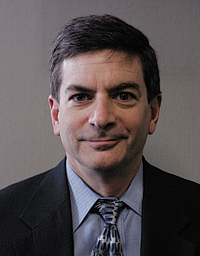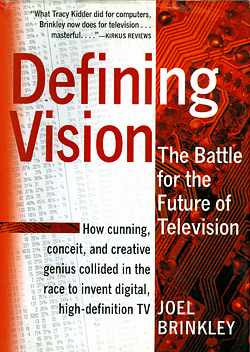Revisiting 'Defining Vision'

Joel BrinkleyWASHINGTON
Joel Brinkley is a Pulitzer Prize-winning journalist who covered everything from wars overseas to technology trends at home in more than 20 years at "The New York Times." His 1998 book chronicling the early stirrings of interest that eventually led to the creation of digital television, "Defining Vision: The Battle for the Future of Television," provided an often riveting account of the monumental shift about to take place in America—a decades-long journey that finally reaches its zenith this year with the industry-wide transition to the ATSC DTV System.
TV Technology Correspondent John Merli, who served as an NAB communications director during much of the timeframe covered in Brinkley's book, recently spoke with the author, who is currently a visiting professor of journalism at Stanford University in California.
TV TECHNOLOGY: Joel, what circumstances led you decide to begin such an ambitious writing project leading to "Defining Vision" in the first place?
BRINKLEY: In 1991, I returned from a several-year assignment in the Middle East and was looking for an interesting new writing project. I spotted a "short," 100-word story in "The New York Times" about what was then called "the HDTV race" and it immediately caught my attention. I was an audiophile as a young man. I built stereo equipment. So I have a natural affinity for audio/video issues. And as a journalist, I immediately saw there had to be drama behind a race of this sort. I did a bit of research and signed up to write a Times magazine piece about the race. Once I began researching that, I realized: This is a book!
TV TECHNOLOGY: Did you uncover any surprises along the way in your research?
BRINKLEY: I uncovered many surprises—primarily the fascinating personalities of the players. The primary surprise was that it proved to be a far more fascinating story then I had imagined. Almost every admirable and reprehensible attribute of human behavior came into play here.
TV TECHNOLOGY: 'Defining Visions' makes the point, among others, that a key attraction of analog HDTV in Japan for NAB was maybe using it as a way to secure unused spectrum for the TV industry—rather than the more noble notion, perhaps, that the industry was simply pursuing a more efficient and modern form of broadcasting for both business and public service purposes. How do you think things may have turned out if John Abel and Tom Keller had not made that fateful trip down to Florida to see those analog HDTV experiments underway in that obscure trailer in a scene that you open your book with?
BRINKLEY: In a broader sense, I do think that if it had not been the broadcasters themselves asking for the right to offer HDTV—even if the motivation was cynical—the FCC would not have started the race.
TV TECHNOLOGY: So according to your book, the road to what later evolved into DTV began with a political decision by NAB? Or do you think (as some observers have since suggested) that it really may have started years earlier with the NHK MUSE tests and with other groups involved besides NAB—such as MSTV, CEA and SMPTE?
BRINKLEY: No, as I said in the book, it all started in this country with the spectrum battle and that [NAB] meeting.

TV TECHNOLOGY: What are your thoughts today on how broadcasting has now evolved into the digital realm—with large flat-screen TVs, HD, LCD, plasma, 1080p, Blu-ray, and the like?
BRINKLEY: I find it quite pleasing to see all that work come to fruition 10 years later. But I fear the government will face a rebellion when it turns off analog broadcasting. I also am saddened to see so many manufacturers 'dumbing down' the standard and producing equipment that provides only a pale shadow of what the standard can offer—aware that most consumers will not be able to tell the difference.
TV TECHNOLOGY: Such as?
BRINKLEY: One issue is the growing predominance of LCD as the display of choice—even though it cannot display the color black, leading to washed-out pictures, and its inability to render fast motion.
TV TECHNOLOGY: All anyone seems to talk about regarding digital TV right now is the HDTV part of the equation, perhaps because HD has proven to be the most compelling way to get to consumers. Yet earlier promises of multicasting and datacast services somehow got forgotten in the rush to digitize, although both do now exist in various forms, notably with some PBS stations. John Abel, for one, greatly regrets this HD-only scenario. Your thoughts?
BRINKLEY: As we all can see with the auto and newspaper industries, mature industries find it virtually impossible to innovate—even when challenged. TV is no different. Given the opportunity to offer their viewers an array of new and innovative services, most TV stations simply simulcast their analog signal and have continued offering little, if anything, new on their digital channels. Even now, when they are about to turn off their analog channels and go back to 6 MHz, they could still innovate when they are not broadcasting HDTV. But once again, I doubt anyone will do much of anything.
TV TECHNOLOGY: Your father, David Brinkley, was a legendary figure in early television and especially TV journalism and the way he helped mold live coverage of major news events—notably political conventions—starting in the 50's when the TV universe provided only a handful of channel choices. Fortunately he lived to read 'Defining Vision' and witness the early stages of the DTV era.
BRINKLEY: My father enjoyed the book and when I was the first consumer in the United States to have an HDTV in my home, in October 1998, he came over to see. I will never forget the smile on his face when he saw the test broadcast of an HD movie—broadcast by the test station WHD-TV.
The professional video industry's #1 source for news, trends and product and tech information. Sign up below.
